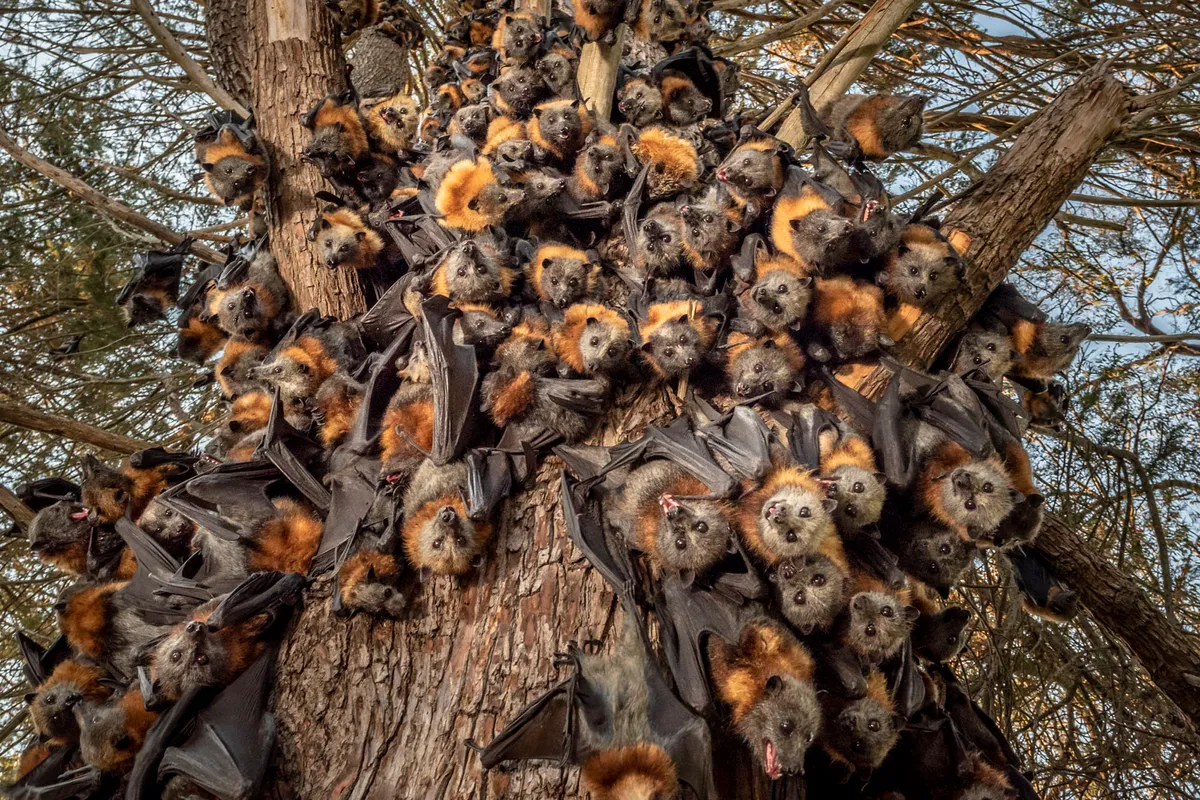About Doug Gimsesy
Doug Gimesy is a conservation, wildlife and animal-welfare photojournalist based in Victoria, Australia.
See more of his work on his website .
Burnt trees on the side of the Bruthen-Buchan Road, South Buchan, Victoria. This area was burnt during the November-Dec 2019 fires. Photographed in January 2020. © Doug Gimesy The smoke from underground peat continuing to burn rises into the air at Sarsfield, Victoria, days after bushfires destroyed much of the town and native habitat in January, 2020. © Doug Gimesy Martins Creek and surrounds in Nurran, Victoria, after the 2019/20 bushfires devastated the area. The edge of the creek had wet temperate rainforest along its edge, bounded by wet and damp forest. Photographed in February, 2020. © Doug Gimesy During an extreme heat-stress event at Melbourne's Yarra Bend grey-headed flying-fox colony, where temperatures exceeded 43°C, in a desperate search for somewhere cooler and less exposed, the bats descend from the safety of the tree canopy looking for a cooler place. Ironically and sadly, this behaviour results in what experts call ‘clumping’ - where the number of bats in close proximity means that the animals get even hotter. It is often a precursor to mass deaths. © Doug Gimesy On the ground there were already many dead bats that had succumbed to this heat-stress event. Park Ranger and grey-headed flying-fox project officer Stephen Brend estimated that during this day, over 4,500 bats died at the Melbourne Yarra Bend colony as temperatures exceeded 43° C - 56% being infants and a significant part of the next generation. © Doug Gimesy A baby koala named ‘Micky’ – one of 6 being evacuated from the Mallacoota wildlife triage centre by to Melbourne for further treatment to burns as a result of the Mallacoota bushfires – is given some food (and health check) at East Sale Airforce Base, by Zoos Victoria veterinary nurse Leanne De Lacy, before continuing his trip by road to Melbourne. Photographed in January 2020. © Doug Gimesy The burnt feet of an anesthetised female koala being treated at a mobile wildlife triage centre at Bairnsdale. She was brought in from Gelantipy with 3rd degree burns on hands from walking on hot ground as a result of bushfires, and was also not eating. Photographed in January 2020. © Doug Gimesy A member of the Victorian Police Remote Piloted Aircraft Systems looks at a screen which is displaying an infa red image sent via a drone of a koala high up in a tree in Gelantipy, in Victoria. This drone is being trailed to help Victorian Forest and Wildlife Officers find koalas so that a health check can the be made and determine any impact that resulted from the recent bushfires in the area. Photographed in January 2020. © Doug Gimesy Rena Gaborov from Wallabia Wildlife Shelter with one of her young eastern grey kangaroo orphans sit in her mother’s shed on her property. Rena and her partner Joseph had to evacuate their wildlife (wombats, kangaroos and possums) from their home and wildlife shelter in Goongerah, in Victoria, when bushfires threatened and then destroyed it in December 2019. They have now have now moved back home and started rebuilding their home and wildlife shelter. Photographed in January 2020. © Doug Gimesy A burnt Banksia tree cone, burnt during the recent bushfires. Most Banksia species that occur in fire-prone regions produce woody seed pods that open during or soon after fires - releasing the seeds into the post-fire environment. Photographed in January 2020. © Doug Gimesy A yellow-tailed black cockatoo in a forest near Bruthen, in Victoria, that was burnt from the bushfires, eats the seeds from a burnt Banksia tree. Photographed in January 2020. © Doug Gimesy Epicormic growth/shoots (a plant response to damage or stress) on burnt Eucalyptus trees in Goongerah, Victoria, after bushfires went through the area in December 2019 - January 2020. Photographed in February 2020. © Doug Gimesy Epicormic growth/shoots (a plant response to damage or stress) on burnt Eucalyptus trees in Orbost, Victoria, after bushfires went through the area in December 2019 - January 2020. Photographed in February 2020. © Doug Gimesy 
























